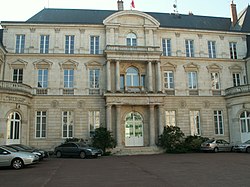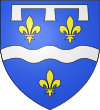Départment of Loiret
| Loiret | |||
|---|---|---|---|
| Department | |||

Prefecture building of the Loiret department, in Orléans
|
|||
|
|||
 Location of Loiret in France |
|||
| Coordinates: 47°55′N 02°10′E / 47.917°N 2.167°ECoordinates: 47°55′N 02°10′E / 47.917°N 2.167°E | |||
| Country | France | ||
| Region | Centre-Val de Loire | ||
| Prefecture | Orléans | ||
| Subprefectures |
Montargis Pithiviers |
||
| Government | |||
| • President of the General Council | Eric Doligé (UMP) | ||
| Area | |||
| • Total | 6,775 km2 (2,616 sq mi) | ||
| Population (2013) | |||
| • Total | 665,587 | ||
| • Rank | 35th | ||
| • Density | 98/km2 (250/sq mi) | ||
| Time zone | CET (UTC+1) | ||
| • Summer (DST) | CEST (UTC+2) | ||
| Department number | 45 | ||
| Arrondissements | 3 | ||
| Cantons | 21 | ||
| Communes | 326 | ||
| ^1 French Land Register data, which exclude estuaries, and lakes, ponds, and glaciers larger than 1 km2 | |||
Loiret (French pronunciation: [lwaʁɛ]) is a department in north-central France.
The department is named after the river Loiret, a tributary of the Loire, and which is located wholly within the department. The capital of the department is Orléans, which is about 110 km (68 mi) southwest of Paris. As well as being the regional capital, it is a historic city on the banks of the Loire. It has a large central area with many historic buildings and mansions, and a cathedral dating back to the thirteenth century that was rebuilt after being destroyed by Protestant forces in 1568. The Loire Valley is famous for its
Loiret is one of the original 83 departments that was created during the French Revolution on March 4, 1790 by order of the National Constituent Assembly. The new departments were to be uniformly administered and approximately equal to one another in size and population. It was created from the former province of Orléanais which was too large to continue in its previous form.
The Loire Valley was occupied in Palaeolithic times as attested by numerous archaeological sites in the department. The Celts were here, bringing crafts and trades, and the Romans occupied the area after the Gallic Wars. They built roads and founded cities such as Cenabum, on the site of present-day Orléans, and Sceaux-du-Gâtinais. Around 451, the Huns invaded the region but were repelled before reaching Cenabum. The Franks reached the Loire and Clovis I reigned in the area. A time of peace and prosperity ensued during the reign of Charlemagne.
...
Wikipedia


